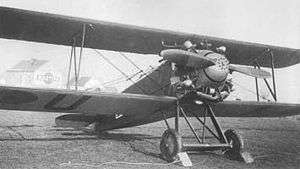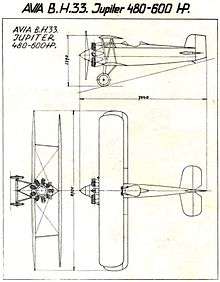Avia BH-33
The Avia BH-33 was a biplane fighter aircraft built in Czechoslovakia in 1927. It was based on the BH-21J which demonstrated promising results by combining the original BH-21 airframe with a licence-built Bristol Jupiter radial engine. Other than the peculiar Avia hallmark of having an upper wing with a shorter span than the lower, it was utterly conventional, even featuring a tail fin for the first time in a Pavel Beneš and Miroslav Hajn design (previous aircraft had a rudder but no fin).
| BH-33 | |
|---|---|
 | |
| Role | Fighter |
| Manufacturer | Avia, PWS (under licence), Ikarus (under licence) |
| Designer | Miroslav Hajn and Pavel Beneš |
| First flight | 21 October 1927 |
| Primary users | Czechoslovak Air Force Polish Air Force Yugoslav Royal Air Force |
| Produced | Ca. 110, plus 50 licence-built in Poland and 22 in Yugoslavia |
| Developed from | Avia BH-21 |

Design and development
Initial tests of the first prototype were disappointing, displaying performance only marginally better than the BH-21, even when fitted with a more powerful version of the Jupiter. Two further prototypes followed, both designated BH-33-1, each with an increasingly powerful Jupiter variant – one a Jupiter VI, the other a Jupiter VII. The performance of the latter example was finally acceptable for the Czechoslovakian defence ministry to order a small production run of only five aircraft.
Three examples were sold to Belgium, where there were plans to build the type under licence, but this did not occur. Licence production was undertaken, however, in Poland, where a single example was sold, along with a licence to build 50 aircraft. These were designated PWS-A and put into service with the Polish Air Force in 1930.[1]
Development continued with an almost total redesign of the fuselage, replacing the wooden, slab-sided structure with one of oval cross-section, built up from welded steel tubes. Designated BH-33E, this was a world-class fighter for its time. Nevertheless, the response from the Czechoslovakian military was lukewarm (although two were bought for the national aerobatics team), and Avia again looked abroad for customers, this time selling 20 aircraft to the Kingdom of Yugoslavia, along with a licence to produce another 24. Two or three examples were also bought by Soviet Union for evaluation.[2]
In late 1929, a further development was flown as the BH-33L, featuring longer-span wings, and a Škoda L W-block engine. This version finally brought the company the domestic sales that it had been hoping for, with 80 aircraft ordered by the Czechoslovak Air Force. These became standard equipment with some air regiments up to the outbreak of World War II.[3]
A single, final variant with a BMW-built Pratt & Whitney Hornet engine was built as the BH-33H (later redesignation BH-133) in 1930, but this did not lead to production.
Operational history
Czechoslovakian BH-33s never saw combat, and Poland's examples had long been replaced in service by the time of the German invasion. Two Yugoslavian machines did, however see combat against Luftwaffe Messerschmitt Bf 109s, but were both destroyed and their pilots killed.
Variants
- BH-33
- First prototype.
- BH-33-1
- Two prototypes powered by Jupiter VI (second) and Jupiter VII (third) engines plus five serial built aircraft with Jupiter VII engine.
- BH-33E
- Rebuilt fuselage
- BH-33E-SHS
- Yugoslav Version powered by IAM K9 engine, 22 built.[4]
- BH-33L
- Version with longer-span wings, powered by a Škoda L engine, 80 built.
- BH-33H (BH-133)
- Version powered by Pratt & Whitney Hornet engine, one built.
- P.W.S.A
- Polish license-built variant of the BH-33 with minor modifications,[1] 50 built between 1929 and 1932.
Operators
- Belgian Air Force received three BH-33-1 aircraft.
- Air Force of the Independent State of Croatia
- Czechoslovakian Air Force
- Czechoslovakian National Security Guard
- Hellenic Air Force acquired five Yugoslav-produced BH-33s, during the 1935 coup, when Greece was a republic.
- Polish Air Force received one BH-33 and 50 PWS-A license-built variant.
- Soviet Air Force bought two or three BH-33Es for tests.
- Yugoslav Royal Air Force
Specifications (BH-33L)

Data from Jane's all the World's Aircraft 1928,[5] Combat aircraft of the world[6]
General characteristics
- Crew: one, pilot
- Length: 7.22 m (23 ft 8 in)
- Wingspan: 8.90 m (29 ft 2 in)
- Height: 3.13 m (10 ft 3 in)
- Wing area: 25.5 m2 (274 sq ft)
- Empty weight: 1,117 kg (2,463 lb)
- Gross weight: 1,560 kg (3,439 lb)
- Powerplant: 1 × Škoda L , 430 kW (580 hp)
Performance
- Maximum speed: 298 km/h (186 mph, 162 kn)
- Cruise speed: 280 km/h (174 mph, 151 kn)
- Range: 450 km (280 mi, 240 nmi)
- Service ceiling: 8,000 m (26,247 ft)
- Rate of climb: 9.9 m/s (1,940 ft/min)
Armament
- 2 × fixed, forward-firing 7.7 mm (.303 in) Vickers machine guns
- 2 × fixed,forward-firing 7.92mm vz.28 machine gun[7]
See also
Related development
Related lists
References
- Belcarz 2005, p. 6.
- Taylor 1989, p. 86.
- Taylor and Alexander 1969, p. 58.
- "Archived copy". Archived from the original on 2014-04-07. Retrieved 2014-04-07.CS1 maint: archived copy as title (link)
- Grey, C.G., ed. (1928). Jane's all the World's Aircraft 1928. London: Sampson Low, Marston & company, ltd. p. 77c.
- Taylor, John W. R.; Alexander, Jean; et al. (1969). Combat aircraft of the world. London: Ebury P.; Michael Joseph. p. 58. ISBN 0-71810-564-8.
- http://www.airwar.ru/enc/fww1/bh33.html
Further reading
- Kopański, Tomasz J.; Belcarz, Bartłomiej (2005). Avia BH 33 (PWS A), PWS 10, PZL P.7a (in Czech). Sandomierz: Wydawnictwo Stratus. ISBN 83-89450-36-4.
- Němeček, Vaclav (1968). Československá letadla (in Czech). Praha: Naše Vojsko.
- Taylor, John W. R.; Alexander, Jean; et al. (1969). Combat aircraft of the world. London: Ebury P.; Michael Joseph. p. 58. ISBN 0-71810-564-8.
- Taylor, Michael J.H.; Gunston, Bill; et al. (1989). Jane's encyclopedia of aviation. New York: Portland House. ISBN 0-517-69186-8.
- World Aircraft Information Files. London: Bright Star Publishing, File 889 Sheet 86.